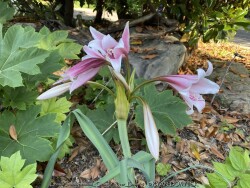

Crinums are tough, long-lived perennial bulbs with strappy leaves and fragrant, funnel-shaped flowers. In areas where the bulbs are hardy, (zones 5/6-10) these plants can reach as much as 4 feet across and bloom all summer. Crinums can live for 200-300 years in the South often found growing in cemeteries and abandoned home sites with little or no attention. The plants are native to southeast Asia often in areas with a summer monsoon and dry winter. They can also be grown as flowering summer patio plants. If growing as a potted plant and trying to overwinter, allowing the foliage to frost is ok, it will not kill the root system. However, do not allow the pot with rootball to freeze solid or go below 20 degrees for more than a few hours; move into a cold garage or basement over the winter with no watering. Cut back and allow to go dormant and place entire pot back out in April or May with a time-release fertilizer. During the growing season, fertilize, water regularly, and place in full sun. You may also plant these in the ground for an enormous tropical effect! It is easy to overwinter these in the ground in Kansas with mulch or no mulch! The trick is to plant them deep: an extra 4-6" deeper than grade or with neck of bulb completely buried. Crinums are extremely adaptable thriving in either in dry or in boggy soils. Crinums are tough, low maintenance bulbs which make them perfect for rain gardens, and although drought-tolerant, crinums bloom more if well-watered. Unlike southern climates, crinums in Kansas need full sun to grow and flower in our shorter growing season. Crinum are more cold hardy than most authorities publish; easily pushing into zone 5 for some varieties. In our trial gardens in Lawrence, KS (zone 6a), the following varieties survived after being mulched 6-12" with leaf mulch to -17 degrees F. (Crinum 'Infusion', Crinum tweedianum, Crinum 'Super Ellen', Crinum x powellii, Crinum 'White Prince') During the arctic blast of February, 2021, lows down to -17 degrees F on Feb 16th, 2021 were recorded. The longevity of this cold blast was also impressive: 10 days on a row with highs of 10-15 degrees F or lower, 8 nights of lows in the single digits and negatives, and 36 straight hours of 0 degrees F and mostly lower. No crinums were lost or harmed during this event! Crinum bulbispermum 'Orange River Basin' is a form of the extremely winter hardy (zone 5) Crinum bulbispermum from South Africa's Orange River area at around 9,000' elevation 'Orange River Basin' forms a lovely non-offsetting clump of glaucous blue foliage and white flowers with pink and magenta throat.
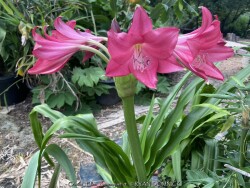

Crinums are tough, long-lived perennial bulbs with strappy leaves and fragrant, funnel-shaped flowers. In areas where the bulbs are hardy, (zones 5/6-10) these plants can reach as much as 4 feet across and bloom all summer. Crinums can live for 200-300 years in the South often found growing in cemeteries and abandoned home sites with little or no attention. The plants are native to southeast Asia often in areas with a summer monsoon and dry winter. They can also be grown as flowering summer patio plants. If growing as a potted plant and trying to overwinter, allowing the foliage to frost is ok, it will not kill the root system. However, do not allow the pot with rootball to freeze solid or go below 20 degrees for more than a few hours; move into a cold garage or basement over the winter with no watering. Cut back and allow to go dormant and place entire pot back out in April or May with a time-release fertilizer. During the growing season, fertilize, water regularly, and place in full sun. You may also plant these in the ground for an enormous tropical effect! It is easy to overwinter these in the ground in Kansas with mulch or no mulch! The trick is to plant them deep: an extra 4-6" deeper than grade or with neck of bulb completely buried. Crinums are extremely adaptable thriving in either in dry or in boggy soils. Crinums are tough, low maintenance bulbs which make them perfect for rain gardens, and although drought-tolerant, crinums bloom more if well-watered. This plant can also grow in standing water or as a potted plant in water gardens. Unlike southern climates, crinums in Kansas need full sun to grow and flower in our shorter growing season. Crinum are more cold hardy than most authorities publish; easily pushing into zone 5 for some varieties. In our trial gardens in Lawrence, KS (zone 6a), the following varieties survived after being mulched 6-12" with leaf mulch to -17 degrees F. (Crinum 'Infusion', Crinum tweedianum, Crinum 'Super Ellen', Crinum x powellii, Crinum 'White Prince') During the arctic blast of February, 2021, lows down to -17 degrees F on Feb 16th, 2021 were recorded. The longevity of this cold blast was also impressive: 10 days on a row with highs of 10-15 degrees F or lower, 8 nights of lows in the single digits and negatives, and 36 straight hours of 0 degrees F and mostly lower. No crinums were lost or harmed during this event!


Crinums are tough, long-lived perennial bulbs with strappy leaves and fragrant, funnel-shaped flowers. In areas where the bulbs are hardy, (zones 5/6-10) these plants can reach as much as 4 feet across and bloom all summer. Crinums can live for 200-300 years in the South often found growing in cemeteries and abandoned home sites with little or no attention. The plants are native to southeast Asia often in areas with a summer monsoon and dry winter. They can also be grown as flowering summer patio plants. If growing as a potted plant and trying to overwinter, allowing the foliage to frost is ok, it will not kill the root system. However, do not allow the pot with rootball to freeze solid or go below 20 degrees for more than a few hours; move into a cold garage or basement over the winter with no watering. Cut back and allow to go dormant and place entire pot back out in April or May with a time-release fertilizer. During the growing season, fertilize, water regularly, and place in full sun. You may also plant these in the ground for an enormous tropical effect! It is easy to overwinter these in the ground in Kansas with mulch or no mulch! The trick is to plant them deep: an extra 4-6" deeper than grade or with neck of bulb completely buried. Crinums are extremely adaptable thriving in either in dry or in boggy soils. Crinums are tough, low maintenance bulbs which make them perfect for rain gardens, and although drought-tolerant, crinums bloom more if well-watered. This plant can also grow in standing water or as a potted plant in water gardens. Unlike southern climates, crinums in Kansas need full sun to grow and flower in our shorter growing season. Crinum are more cold hardy than most authorities publish; easily pushing into zone 5 for some varieties. In our trial gardens in Lawrence, KS (zone 6a), the following varieties survived after being mulched 6-12" with leaf mulch to -17 degrees F. (Crinum 'Infusion', Crinum tweedianum, Crinum 'Super Ellen', Crinum x powellii, Crinum 'White Prince') During the arctic blast of February, 2021, lows down to -17 degrees F on Feb 16th, 2021 were recorded. The longevity of this cold blast was also impressive: 10 days on a row with highs of 10-15 degrees F or lower, 8 nights of lows in the single digits and negatives, and 36 straight hours of 0 degrees F and mostly lower. No crinums were lost or harmed during this event!
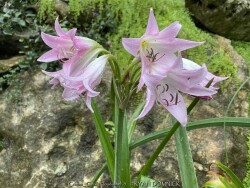

Crinums are tough, long-lived perennial bulbs with strappy leaves and fragrant, funnel-shaped flowers. In areas where the bulbs are hardy, (zones 5/6-10) these plants can reach as much as 4 feet across and bloom all summer. Crinums can live for 200-300 years in the South often found growing in cemeteries and abandoned home sites with little or no attention. The plants are native to southeast Asia often in areas with a summer monsoon and dry winter. They can also be grown as flowering summer patio plants. If growing as a potted plant and trying to overwinter, allowing the foliage to frost is ok, it will not kill the root system. However, do not allow the pot with rootball to freeze solid or go below 20 degrees for more than a few hours; move into a cold garage or basement over the winter with no watering. Cut back and allow to go dormant and place entire pot back out in April or May with a time-release fertilizer. During the growing season, fertilize, water regularly, and place in full sun. You may also plant these in the ground for an enormous tropical effect! It is easy to overwinter these in the ground in Kansas with mulch or no mulch! The trick is to plant them deep: an extra 4-6" deeper than grade or with neck of bulb completely buried. Crinums are extremely adaptable thriving in either in dry or in boggy soils. Crinums are tough, low maintenance bulbs which make them perfect for rain gardens, and although drought-tolerant, crinums bloom more if well-watered. This plant can also grow in standing water or as a potted plant in water gardens. Unlike southern climates, crinums in Kansas need full sun to grow and flower in our shorter growing season. Crinum are more cold hardy than most authorities publish; easily pushing into zone 5 for some varieties. In our trial gardens in Lawrence, KS (zone 6a), the following varieties survived after being mulched 6-12" with leaf mulch to -17 degrees F. (Crinum 'Infusion', Crinum tweedianum, Crinum 'Super Ellen', Crinum x powellii, Crinum 'White Prince') During the arctic blast of February, 2021, lows down to -17 degrees F on Feb 16th, 2021 were recorded. The longevity of this cold blast was also impressive: 10 days on a row with highs of 10-15 degrees F or lower, 8 nights of lows in the single digits and negatives, and 36 straight hours of 0 degrees F and mostly lower. No crinums were lost or harmed during this event! Crinum x powellii produces pink flowers. 48" tall
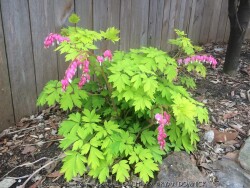

>>>>>Gold Heart Pink Bleeding Heart, is also known as Dicentra / Lamprocapnos spectabilis 'Gold Heart'. It can handle a little Kansas drought in in moisture-retentive soils but not dry-shade. Foliage will flatten to the ground during drought then spring back up when moisture is available again. Generally however, in non-irrigated or poor soil areas, this plant will decline and allow weeds to intermix.
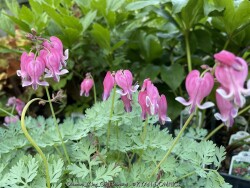

>>>>>King of Hearts Fringed Bleeding Heart, is also known as Dicentra x 'King of Hearts'. It can handle a little Kansas drought in in moisture-retentive soils but not dry-shade. Foliage will flatten to the ground during drought then spring back up when moisture is available again. Generally however, in non-irrigated or poor soil areas, this plant will decline and allow weeds to intermix.
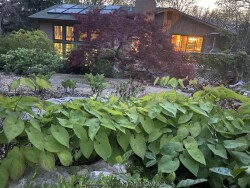

Barrenwort (Epimedium) features compact dainty mounds of green to colored weed-resistant foliage. Wispy flowers appear above emerging foliage in mid-spring. Improved breeding has resulted in many different flower colors even including orange. Semi-evergreen foliage can sometimes look bedraggled by late summer if there is too much overhead watering and humidity. Barrenwort prefers average to dry garden conditions and even thrive and dry shade. Plantings can thrive for decades if in the right spot; there is no such thing as overcrowding for Barrenwort. When planted in mass, growth is slow at first but eventually a cake-like rhizome system will form and completely smother out any weeds and compete well with trees for water and nutrients. While barrenwort can tolerate full sun, they prefer part to full shade. Sun burning is possible with temperatures over 100° and there are better plants to use in hot areas. Due to slow spreading growth, you shouldn't leave very much room in-between barrenwort plants or you will be waiting many years for the patch to fill in. Weeds can be a problem in that open area between plants if spacing is too wide. We recommend 9-12" spacing and use for small nooks in the shade garden. If planning for a larger area, still figure on the tight spacing but allow for a higher budget that you will consider a permanent investment. Barrenwort is a real trooper for the dry shade garden!
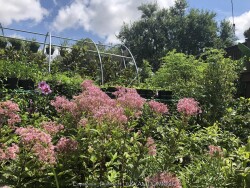

Phantom Dwarf Purple Eupatorium, is also known as Eupatorium 'Phantom'
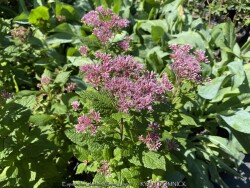

Little Joe Purple Eupatorium / Joe Pye, is also known as Eupatorium dubium 'Little Joe'
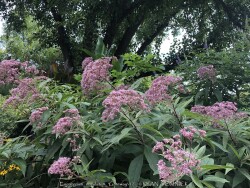

Gateway Purple Eupatorium / Joe Pye, is also known as Eupatorium maculatum 'Gateway'
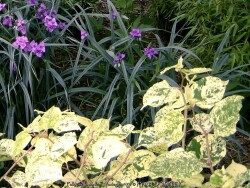

Variegated Fallopia, is also known as Fallopia japonica 'Variegata'
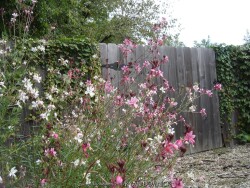

***Description for this perennial available with future update!***
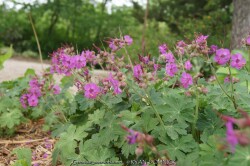

Geranium macrorrhizum, commonly called Bigroot Geranium is native to the Southeast Alps and the Balkans. It features highly aromatic fuzzy leaves that leave you wanting another sniff after crushing a leaf in your hand. Early summer pink, rose, or white flowers form depending on the cultivar. It forms a weed-suppressing mat of rhizomatous semi-evergreen perennial that typically grows to 12" tall but spreads to 24" wide. Root rot can be a problem in poor drainage areas. Bigroot Geranium is the most drought tolerant of the hardy geraniums earning a spot in the dry shade garden; it cannot handle extreme drought or extremely rootbound soils though. It prefers average to dry garden conditions with dappled or morning sun. Sun burning is possible with temperatures over 100° so avoid full afternoon sun. Plantings can thrive for decades if in the right spot as there is no such thing as overcrowding for Big Root Geranium. When planted in mass, growth is slow at first but eventually a cake-like rhizome system will form and completely smother out any weeds and compete well with trees for water and nutrients. The growth rate is slow at first so space new plants relatively close together is desiring this effect.
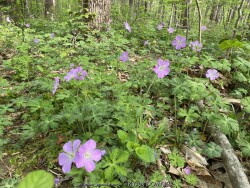

***Description for this perennial available with future update!***
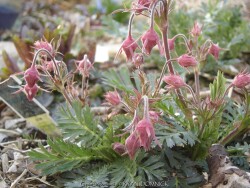

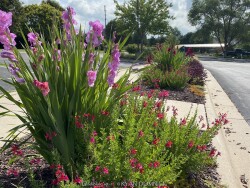

Raintree Hardy Gladiolus (Gladiolus 'Raintree') are typically grown for their mid-summer flowers and vertical iris-leaf foliage. The plants are temperate and subtropical herbaceous perennial bulbs native to areas with a summer wet season and dry winter. Gladiolus are hardy outside as a perennial when established and with minimal effort at least up to zone 6a. During the growing season, fertilize, water regularly, and plant in full sun. Plant these bulbs in the ground at least 6-8" deep with 3-4" of mulch to enjoy a wonderful tropical flowering effect! Foliage may look bedwraggled by fall so it is ok to cut back foliage at that time. They can also be grown as a flowering summer patio plant. If growing as a potted plant and trying to overwinter, allowing the foliage to frost is ok, it will not kill the root system. However, do not allow the pot with rootball to freeze solid or go below 20 degrees for more than a few hours; move into a cold garage or basement over the winter with no watering. Cut back and allow to go dormant and place entire pot back out in April or May with a time-release fertilizer. Another more labor intensive way to overwinter gladiolus is to remove them from the dirt, dust with fungicide, place in box with sawdust, and keep in the refrigerator. We consider this method old-fashioned and too much work but ok if you only want to save a few bulbs. If digging from the ground in colder zones, just save a big chunk with the dirt intact and place into a large pot in the garage. In a customer's garden in Lawrence, KS (zone 6a), four established specimens planted over 4-6" deep and mulched 2-3" with wood mulch survived -17 degrees F. During the arctic blast of February, 2021, lows down to -17 degrees F on Feb 16th, 2021 were recorded. The longevity of this cold blast was also impressive: 10 days on a row with highs of 10-15 degrees F or lower, 8 nights of lows in the single digits and negatives, and 36 straight hours of 0 degrees F and mostly lower. We plan to propagate these 'Raintree' clones in 2022-2023.
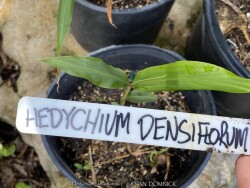

Hardy Ginger (Hedychium) are typically grown for their late summer flowers and vertical wide-leaf foliage. The plants are large tropical and subtropical herbaceous perennials with a rhizomatous rootstock native to areas with a summer monsoon and dry winter. They can be grown as flowering summer patio plants. If growing as a potted plant and trying to overwinter, allowing the foliage to frost is ok, it will not kill the root system. However, do not allow the pot with rootball to freeze solid or go below 20 degrees for more than a few hours; move into a cold garage or basement over the winter with no watering. Cut back and allow to go dormant and place entire pot back out in April or May with a time-release fertilizer. Another more labor intensive way to overwinter cannas is to remove them from the dirt, dust with fungicide, place in box with sawdust, and keep in the refrigerator. We consider this method old-fashioned and too much work but ok if you only want to save a few pieces. If digging from the ground, just save a big chunk with the dirt intact and place into a large pot in the garage. During the growing season, fertilize, water regularly, and place in full sun. You may also plant these in the ground for an enormous tropical effect! It is possible to overwinter these in the ground in Kansas by mulching 6-12" thick over deeply planted rhizomes. New growth may be slightly delayed but probably quick to regain full height. Native habitat for most hedychiums aligns well with our dry winters and warm humid summers. In our trial gardens in Lawrence, KS (zone 6a), we will be testing several varieties in 2022-2023. Famous plantsman, Tony Avent, owner of Plant Delights Nursery in Raleigh, North Carolina, advised us that hedychiums should survive fine here in the ground when mulched like cannas. Hedychium densiflorum features orange flowers.
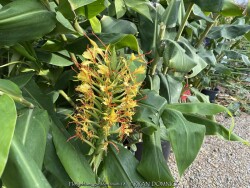

Hardy Ginger (Hedychium) are typically grown for their late summer flowers and vertical wide-leaf foliage. The plants are large tropical and subtropical herbaceous perennials with a rhizomatous rootstock native to areas with a summer monsoon and dry winter. They can be grown as flowering summer patio plants. If growing as a potted plant and trying to overwinter, allowing the foliage to frost is ok, it will not kill the root system. However, do not allow the pot with rootball to freeze solid or go below 20 degrees for more than a few hours; move into a cold garage or basement over the winter with no watering. Cut back and allow to go dormant and place entire pot back out in April or May with a time-release fertilizer. Another more labor intensive way to overwinter cannas is to remove them from the dirt, dust with fungicide, place in box with sawdust, and keep in the refrigerator. We consider this method old-fashioned and too much work but ok if you only want to save a few pieces. If digging from the ground, just save a big chunk with the dirt intact and place into a large pot in the garage. During the growing season, fertilize, water regularly, and place in full sun. You may also plant these in the ground for an enormous tropical effect! It is possible to overwinter these in the ground in Kansas by mulching 6-12" thick over deeply planted rhizomes. New growth may be slightly delayed but probably quick to regain full height. Native habitat for most hedychiums aligns well with our dry winters and warm humid summers. In our trial gardens in Lawrence, KS (zone 6a), we will be testing several varieties in 2022-2023. Famous plantsman, Tony Avent, owner of Plant Delights Nursery in Raleigh, North Carolina, advised us that hedychiums should survive fine here in the ground when mulched like cannas. Butterfly Ginger (Hedychium gardnerianum) is native to the Himalayas in India, Nepal, and Bhutan. The very fragrant pale yellow and red flowers are held in dense spikes above the foliage. Foliage and stems are massive; reaching 6-8 feet tall.
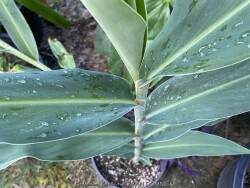

Hardy Ginger (Hedychium) are typically grown for their late summer flowers and vertical wide-leaf foliage. The plants are large tropical and subtropical herbaceous perennials with a rhizomatous rootstock native to areas with a summer monsoon and dry winter. They can be grown as flowering summer patio plants. If growing as a potted plant and trying to overwinter, allowing the foliage to frost is ok, it will not kill the root system. However, do not allow the pot with rootball to freeze solid or go below 20 degrees for more than a few hours; move into a cold garage or basement over the winter with no watering. Cut back and allow to go dormant and place entire pot back out in April or May with a time-release fertilizer. Another more labor intensive way to overwinter cannas is to remove them from the dirt, dust with fungicide, place in box with sawdust, and keep in the refrigerator. We consider this method old-fashioned and too much work but ok if you only want to save a few pieces. If digging from the ground, just save a big chunk with the dirt intact and place into a large pot in the garage. During the growing season, fertilize, water regularly, and place in full sun. You may also plant these in the ground for an enormous tropical effect! It is possible to overwinter these in the ground in Kansas by mulching 6-12" thick over deeply planted rhizomes. New growth may be slightly delayed but probably quick to regain full height. Native habitat for most hedychiums aligns well with our dry winters and warm humid summers. In our trial gardens in Lawrence, KS (zone 6a), we will be testing several varieties in 2022-2023. Famous plantsman, Tony Avent, owner of Plant Delights Nursery in Raleigh, North Carolina, advised us that hedychiums should survive fine here in the ground when mulched like cannas.
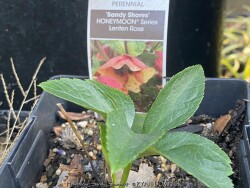

Lenten Rose (Helleborus) is the ultimate dry-shade plant for eastern Kansas landscapes. Most hellebores are native to mountainous wooded regions of Europe with limestone bedrock and calcareous, humus-rich soils. They have everything a gardener might ask for; beautiful spring flowers, dependable dark green foliage, evergreen during winter, appreciation for alkaline soils, and ease of care with very low maintenance. Hellebores are one of the first perennials to start growing in the spring with flowering occurring even with hard freezes. Flowers last incredibly long 2 to 3 months and finally turn greenish in June. No deadheading is needed because the foliage just absorbs the flower stalks as they fade. Summer and fall foliage is dark green, dependable, and pest-free. Evergreen foliage is hardy to about 0°F. If it gets colder than that, hellebores will be deciduous with no detrimental effects. Desirable self-seeding may gently occur around mother plants. Hellebores do have an Achilles heel however; they cannot tolerate wet or poorly drained soils, not even slightly. In areas with too much rainfall or poorly drained soils, foliage diseases and root rot are likely to occur. Hellebores are also not the best choice for full sun, while they will survive, they will get foliage burn in the summer when over 100°F in afternoon sun. With poisonous foliage, these plants resist deer and rabbit browsing. What a great plant for the dry shade garden! There are many improved flowering cultivars to choose from now. Helleborus 'Sandy Shores' HONEYMOON® is a new series from Walters Gardens hybridizer Hans Hansen. In his breeding work, he selects for plants with notable vigor, showy floral displays with large numbers of blossoms per plant, and rich flower colors.'Sandy Shores' bears 2½-3", single pale apricot flowers with a lovely rosy pink color on the backs.
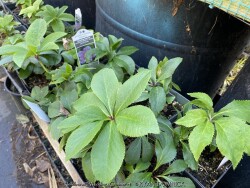

Lenten Rose (Helleborus) is the ultimate dry-shade plant for eastern Kansas landscapes. Most hellebores are native to mountainous wooded regions of Europe with limestone bedrock and calcareous, humus-rich soils. They have everything a gardener might ask for; beautiful spring flowers, dependable dark green foliage, evergreen during winter, appreciation for alkaline soils, and ease of care with very low maintenance. Hellebores are one of the first perennials to start growing in the spring with flowering occurring even with hard freezes. Flowers last incredibly long 2 to 3 months and finally turn greenish in June. No deadheading is needed because the foliage just absorbs the flower stalks as they fade. Summer and fall foliage is dark green, dependable, and pest-free. Evergreen foliage is hardy to about 0°F. If it gets colder than that, hellebores will be deciduous with no detrimental effects. Desirable self-seeding may gently occur around mother plants. Hellebores do have an Achilles heel however; they cannot tolerate wet or poorly drained soils, not even slightly. In areas with too much rainfall or poorly drained soils, foliage diseases and root rot are likely to occur. Hellebores are also not the best choice for full sun, while they will survive, they will get foliage burn in the summer when over 100°F in afternoon sun. With poisonous foliage, these plants resist deer and rabbit browsing. What a great plant for the dry shade garden! There are many improved flowering cultivars to choose from now. Merlin Pink Hellebore (Helleborus x ballardiae HGC 'Merlin') features large outward-facing pink flowers that last 6-8 weeks. Prominent veining on leathery evergreen foliage is showy even when not in bloom.
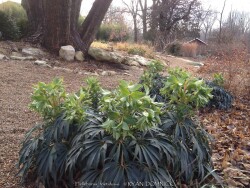

Bear Claw / Stinking Hellebore (Helleborus foetidus) is the ultimate dry-shade plant for eastern Kansas landscapes. Most hellebores are native to mountainous wooded regions of Europe and Asia with limestone bedrock and calcareous, humus-rich soils. They have everything a gardener might ask for; beautiful spring flowers, dependable dark green foliage, evergreen during winter, appreciation for alkaline soils, and ease of care with very low maintenance. Hellebores are one of the first perennials to start growing in the spring with flowering occurring even with hard freezes. Bear Claw Hellebore literally starts blooming in January and February in zone 6a. The drooping cup-shaped flowers appear in spring, and are yellowish-green, often with a purple edge to the five petal-like sepals on strongly upright stems. The flowers are very attractive to bees and other insects at a time of year when hardly any other plant (except Witchhazel / Hamamelis) is blooming. Despite its common name, it is not noticeably malodorous, although the foliage is pungent when crushed. Greenish flowers last incredibly long 2 to 3 months and finally turn brown in May and should be dead-headed. Summer and fall foliage is bear claw-like, dark green, dependable, and pest-free. Evergreen foliage is hardy to about -10°F with complete death occurring at about -15°F for unmulched plants. Desirable self-seeding will occur around mother plants. Individual plants of this species usually live for 3-4 years so it is advisable to allow a patch of different aged plants. Flowering usually occurs at 2-3 years. Hellebores do have an Achilles heel however; they cannot tolerate wet or poorly drained soils, not even slightly. In areas with too much rainfall or poorly drained soils, foliage diseases and root rot are likely to occur. Hellebores are also not the best choice for full sun, while they will survive, they will get foliage burn in the summer when over 100°F in afternoon sun. This hellebore is less adapted to consistent summer heat and humidity of zone 7b areas or South. With poisonous foliage, these plants resist deer and rabbit browsing. What a great plant for the dry shade garden! There are a few interesting and improved cultivars but are rarely available.
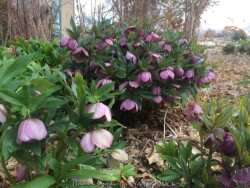

Lenten Rose (Helleborus) is the ultimate dry-shade plant for eastern Kansas landscapes. Most hellebores are native to mountainous wooded regions of Europe with limestone bedrock and calcareous, humus-rich soils. They have everything a gardener might ask for; beautiful spring flowers, dependable dark green foliage, evergreen during winter, appreciation for alkaline soils, and ease of care with very low maintenance. Hellebores are one of the first perennials to start growing in the spring with flowering occurring even with hard freezes. Flowers last incredibly long 2 to 3 months and finally turn greenish in June. No deadheading is needed because the foliage just absorbs the flower stalks as they fade. Summer and fall foliage is dark green, dependable, and pest-free. Evergreen foliage is hardy to about 0°F. If it gets colder than that, hellebores will be deciduous with no detrimental effects. Desirable self-seeding may gently occur around mother plants. Hellebores do have an Achilles heel however; they cannot tolerate wet or poorly drained soils, not even slightly. In areas with too much rainfall or poorly drained soils, foliage diseases and root rot are likely to occur. Hellebores are also not the best choice for full sun, while they will survive, they will get foliage burn in the summer when over 100°F in afternoon sun. With poisonous foliage, these plants resist deer and rabbit browsing. What a great plant for the dry shade garden! There are many improved flowering cultivars to choose from now.


Lenten Rose (Helleborus) is the ultimate dry-shade plant for eastern Kansas landscapes. Most hellebores are native to mountainous wooded regions of Europe with limestone bedrock and calcareous, humus-rich soils. They have everything a gardener might ask for; beautiful spring flowers, dependable dark green foliage, evergreen during winter, appreciation for alkaline soils, and ease of care with very low maintenance. Hellebores are one of the first perennials to start growing in the spring with flowering occurring even with hard freezes. Flowers last incredibly long 2 to 3 months and finally turn greenish in June. No deadheading is needed because the foliage just absorbs the flower stalks as they fade. Summer and fall foliage is dark green, dependable, and pest-free. Evergreen foliage is hardy to about 0°F. If it gets colder than that, hellebores will be deciduous with no detrimental effects. Desirable self-seeding may gently occur around mother plants. Hellebores do have an Achilles heel however; they cannot tolerate wet or poorly drained soils, not even slightly. In areas with too much rainfall or poorly drained soils, foliage diseases and root rot are likely to occur. Hellebores are also not the best choice for full sun, while they will survive, they will get foliage burn in the summer when over 100°F in afternoon sun. With poisonous foliage, these plants resist deer and rabbit browsing. What a great plant for the dry shade garden! There are many improved flowering cultivars to choose from now.
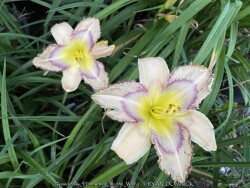

Pink Daylily, is also known as Hemerocallis cultivar.
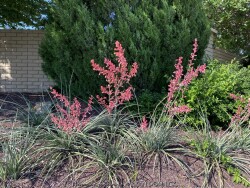

Texas Red Yucca (Hesperaloe parviflora) is a slow-growing broadleaf evergreen perennial with tall coral red flowers! Surprisingly, a native of Northeastern Mexico and Southwestern Texas can handle our extreme cold and wetness of Lawrence, KS! Normally thriving in hot, dry, desert conditions, is also surprisingly winter hardy to USDA Zone 5. Medium to blue-green leaves form rosettes about 2-3 feet tall and wide. Tall red flower spikes reliably appear on mature plants from July to October lasting 3-4 months in Kansas. If pollination is successful, attractive seed heads form later turning to black before cracking open in winter. Tough as nails, yuccas are the ideal plant for a no-maintenance garden. Normally a plant has specific requirements for success but this yucca has only a few: it cannot tolerate poorly drained soils, full shade, or North exposures. This and other yuccas look best when combined with other flowering plants providing texture and color. In mass plantings, red yucca can create an interesting architectural look. Combined with ornamental grasses, red yucca can create stunning contrasts with winter grass colors of pink, orange and rust. Red flowers are pollinated by hummingbirds and certainly deserve a place in native plant / pollinator garden. Not a true yucca, this is actually a Hesperaloe, a closely related genus also related to century plants. A large group of Hesperaloe survived -16 degrees F and a week of single digit highs in February, 2021 with no mulch. I have also seen miles upon miles of this plant growing in the medians along multi-lane interstates in Dallas. All plants were healthy looking with no missing or dying plants; truely a tough plant. Truely a 4-seasons plant for your yard!
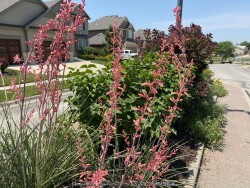

Texas Red Yucca (Hesperaloe parviflora) is a slow-growing broadleaf evergreen perennial with tall coral red flowers! Surprisingly, a native of Northeastern Mexico and Southwestern Texas can handle our extreme cold and wetness of Lawrence, KS! Normally thriving in hot, dry, desert conditions, is also surprisingly winter hardy to USDA Zone 5. Medium to blue-green leaves form rosettes about 2-3 feet tall and wide. Tall red flower spikes reliably appear on mature plants from July to October lasting 3-4 months in Kansas. If pollination is successful, attractive seed heads form later turning to black before cracking open in winter. Tough as nails, yuccas are the ideal plant for a no-maintenance garden. Normally a plant has specific requirements for success but this yucca has only a few: it cannot tolerate poorly drained soils, full shade, or North exposures. This and other yuccas look best when combined with other flowering plants providing texture and color. In mass plantings, red yucca can create an interesting architectural look. Combined with ornamental grasses, red yucca can create stunning contrasts with winter grass colors of pink, orange and rust. Red flowers are pollinated by hummingbirds and certainly deserve a place in native plant / pollinator garden. Not a true yucca, this is actually a Hesperaloe, a closely related genus also related to century plants. A large group of Hesperaloe survived -16 degrees F and a week of single digit highs in February, 2021 with no mulch. I have also seen miles upon miles of this plant growing in the medians along multi-lane interstates in Dallas. All plants were healthy looking with no missing or dying plants; truely a tough plant. Truely a 4-seasons plant for your yard!


Caramel coral bells (Heuchera 'Caramel') are planted for its unusual orange-copper-peach evergreen leaf colors. Tiny light pink flowers also appear in early summer. Foliage maintains well as a non-spreading clump all year provided that certain cultural conditions are met. Native to Eastern U.S. forests in humusy, medium well-drained soil in part shade to full shade, it needs constantly moist soil rich in organic matter but avoid clay. Summer droughts and temperatures over 100 degrees F. are stressful for coral belles. If low temperatures hit -10 degrees F, foliage finally dies back to the ground and re-emerges in early spring. Useful in Kansas landscapes as a small scale groundcover in part shade or morning sun. Color is less intense in full shade. Generally this plant declines after a few years of Kansas climate but worth a try in perfect soils in well-tended shade gardens. Preferring northern climates, lack of moisture, alkaline soils, and competition with weeds seem to be an issue. 'Carmel' is a villosa hybrid with glowing golden-orange leaves turning a bit more apricot with warmer weather. Foliage is fuzzy giving the plants a more frosted look. For a coral bell, this cultivar is very heat and humidity tolerant; a vigorous grower. We have a specimen thriving in our Lawrence, KS, for over 10 years needing very little care; it gets morning sun, regular irrigation, and that's about it! All Proven Winners® plants are legally propagated, healthy and vigorous, true to name, and tagged with color pictures and growing information.


Obsidian Coral Bells (Heuchera x 'Obsidian') are planted for its unusual orange-copper-peach evergreen leaf colors. Tiny light pink flowers also appear in early summer. Foliage maintains well as a non-spreading clump all year provided that certain cultural conditions are met. Native to Eastern U.S. forests in humusy, medium well-drained soil in part shade to full shade, it needs constantly moist soil rich in organic matter but avoid clay. Summer droughts and temperatures over 100 degrees F. are stressful for coral belles. If low temperatures hit -10 degrees F, foliage finally dies back to the ground and re-emerges in early spring. Useful in Kansas landscapes as a small scale groundcover in part shade or morning sun. Color is less intense in full shade. Generally this plant declines after a few years of Kansas climate but worth a try in perfect soils in well-tended shade gardens. Preferring northern climates, lack of moisture, alkaline soils, and competition with weeds seem to be an issue. 'Carmel' is a villosa hybrid with glowing golden-orange leaves turning a bit more apricot with warmer weather. Foliage is fuzzy giving the plants a more frosted look. For a coral bell, this cultivar is very heat and humidity tolerant; a vigorous grower. We have a specimen thriving in our Lawrence, KS, for over 10 years needing very little care; it gets morning sun, regular irrigation, and that's about it! All Proven Winners® plants are legally propagated, healthy and vigorous, true to name, and tagged with color pictures and growing information.
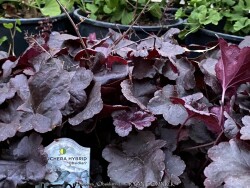

Obsidian Coral Bells (Heuchera x 'Obsidian') are planted for its unusual orange-copper-peach evergreen leaf colors. Tiny light pink flowers also appear in early summer. Foliage maintains well as a non-spreading clump all year provided that certain cultural conditions are met. Native to Eastern U.S. forests in humusy, medium well-drained soil in part shade to full shade, it needs constantly moist soil rich in organic matter but avoid clay. Summer droughts and temperatures over 100 degrees F. are stressful for coral belles. If low temperatures hit -10 degrees F, foliage finally dies back to the ground and re-emerges in early spring. Useful in Kansas landscapes as a small scale groundcover in part shade or morning sun. Color is less intense in full shade. Generally this plant declines after a few years of Kansas climate but worth a try in perfect soils in well-tended shade gardens. Preferring northern climates, lack of moisture, alkaline soils, and competition with weeds seem to be an issue. 'Carmel' is a villosa hybrid with glowing golden-orange leaves turning a bit more apricot with warmer weather. Foliage is fuzzy giving the plants a more frosted look. For a coral bell, this cultivar is very heat and humidity tolerant; a vigorous grower. We have a specimen thriving in our Lawrence, KS, for over 10 years needing very little care; it gets morning sun, regular irrigation, and that's about it! All Proven Winners® plants are legally propagated, healthy and vigorous, true to name, and tagged with color pictures and growing information.
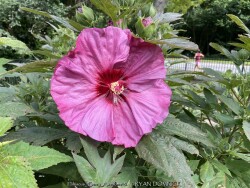

Hardy Hibiscus are US native plants that feature very large single petal flowers sometimes as large as a dinner plate. Colors include white, pink, red, magenta, purple with many different combinations. Foliage can range from green to reddish to dark purplish black. Hardy hibiscus breeding to produce improved cultivars has come a long way in the last 10 or 20 years. Hibiscus emerge later than most other perennials, needing the ground to heat up before growing in May. Hibiscus tolerate a wide range of soil conditions including clay and wetness but prefer rich garden soil. Drought is tolerated with established plants although flowering will be reduced. Generally, the 40 inches of rainfall in Eastern Kansas is sufficient. Full sun is best for optimal foliage coloring, growth habit, and flowers. When used in a landscape, hibiscus brings a tropical feel when flowering and are noticeable from very far away. Combine with hardy bananas (musa basjoo) and other contrasting flowers. Groupings of hibiscus are very effective around water gardens, rain gardens, backyard fences, pollinator gardens, and roadside areas where you only have a second to look when driving by. Modern hibiscus cultivars do not set seed and do not need to be deadheaded like old varieties; the result is continuous blooming from July till September. Cool autumn nights below 50 degrees F initiate beautiful fall foliage colors ranging from red and purple to fiery orange. Maintenance is pretty easy: just cut down dead stocks to the ground at some point in fall or winter. A yearly time-release fertilizer is appreciated from most heavily flowering plants. There are some occasional foliage pests for hibiscuses including leaf miners, grasshoppers, and Japanese beetles but these can be treated. If not treated, it generally won't kill the plant, especially if the plant is otherwise healthy and in good growing conditions. Summerific® 'Berry Awesome' Rose Mallow (Hibiscus 'Berry Awesome') is a Walters Gardens Inc. introduction. Huge 7-8", ruffled, lavender pink flowers with a cherry red eye are produced all over the densely compact, shrub-like clump of attractive midnight green foliage. Similar color to 'Plum Crazy'. All Proven Winners® plants are legally propagated, healthy and vigorous, true to name, and tagged with color pictures and growing information.


Hardy Hibiscus are US native plants that feature very large single petal flowers sometimes as large as a dinner plate. Colors include white, pink, red, magenta, purple with many different combinations. Foliage can range from green to reddish to dark purplish black. Hardy hibiscus breeding to produce improved cultivars has come a long way in the last 10 or 20 years. Hibiscus emerge later than most other perennials, needing the ground to heat up before growing in May. Hibiscus tolerate a wide range of soil conditions including clay and wetness but prefer rich garden soil. Drought is tolerated with established plants although flowering will be reduced. Generally, the 40 inches of rainfall in Eastern Kansas is sufficient. Full sun is best for optimal foliage coloring, growth habit, and flowers. When used in a landscape, hibiscus brings a tropical feel when flowering and are noticeable from very far away. Combine with hardy bananas (musa basjoo) and other contrasting flowers. Groupings of hibiscus are very effective around water gardens, rain gardens, backyard fences, pollinator gardens, and roadside areas where you only have a second to look when driving by. Modern hibiscus cultivars do not set seed and do not need to be deadheaded like old varieties; the result is continuous blooming from July till September. Cool autumn nights below 50 degrees F initiate beautiful fall foliage colors ranging from red and purple to fiery orange. Maintenance is pretty easy: just cut down dead stocks to the ground at some point in fall or winter. A yearly time-release fertilizer is appreciated from most heavily flowering plants. There are some occasional foliage pests for hibiscuses including leaf miners, grasshoppers, and Japanese beetles but these can be treated. If not treated, it generally won't kill the plant, especially if the plant is otherwise healthy and in good growing conditions. Hibiscus 'Candy Crush' is a Walters Gardens Inc. introduction. It features bright bubblegum pink flowers have a near-black, dark red eye and are produced all over its habit of rich, bright green leaves. Use in place of a shrub to provide structure in your sun garden. A perfect addition to the late summer garden.
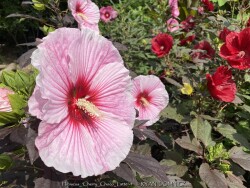

Hardy Hibiscus are US native plants that feature very large single petal flowers sometimes as large as a dinner plate. Colors include white, pink, red, magenta, purple with many different combinations. Foliage can range from green to reddish to dark purplish black. Hardy hibiscus breeding to produce improved cultivars has come a long way in the last 10 or 20 years. Hibiscus emerge later than most other perennials, needing the ground to heat up before growing in May. Hibiscus tolerate a wide range of soil conditions including clay and wetness but prefer rich garden soil. Drought is tolerated with established plants although flowering will be reduced. Generally, the 40 inches of rainfall in Eastern Kansas is sufficient. Full sun is best for optimal foliage coloring, growth habit, and flowers. When used in a landscape, hibiscus brings a tropical feel when flowering and are noticeable from very far away. Combine with hardy bananas (musa basjoo) and other contrasting flowers. Groupings of hibiscus are very effective around water gardens, rain gardens, backyard fences, pollinator gardens, and roadside areas where you only have a second to look when driving by. Modern hibiscus cultivars do not set seed and do not need to be deadheaded like old varieties; the result is continuous blooming from July till September. Cool autumn nights below 50 degrees F initiate beautiful fall foliage colors ranging from red and purple to fiery orange. Maintenance is pretty easy: just cut down dead stocks to the ground at some point in fall or winter. A yearly time-release fertilizer is appreciated from most heavily flowering plants. There are some occasional foliage pests for hibiscuses including leaf miners, grasshoppers, and Japanese beetles but these can be treated. If not treated, it generally won't kill the plant, especially if the plant is otherwise healthy and in good growing conditions. Summerific® 'Cherry Choco Latte' Hibiscus(Hibiscus 'Cherry Choco Latte') is a brand new, long blooming Hibiscus with a smaller size that is more suitable for tighter spaces. This is a recent Walters Gardens Inc. plant introduction. A perfect late summer perennial! Very large, 8-9" three-dimensional flowers are white with intense deep pink veining and a notably large red eye. Attractive dark olive green foliage forms a compact airy clump. All Proven Winners® plants are legally propagated, healthy and vigorous, true to name, and tagged with color pictures and growing information.
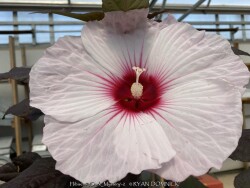

Hardy Hibiscus are US native plants that feature very large single petal flowers sometimes as large as a dinner plate. Colors include white, pink, red, magenta, purple with many different combinations. Foliage can range from green to reddish to dark purplish black. Hardy hibiscus breeding to produce improved cultivars has come a long way in the last 10 or 20 years. Hibiscus emerge later than most other perennials, needing the ground to heat up before growing in May. Hibiscus tolerate a wide range of soil conditions including clay and wetness but prefer rich garden soil. Drought is tolerated with established plants although flowering will be reduced. Generally, the 40 inches of rainfall in Eastern Kansas is sufficient. Full sun is best for optimal foliage coloring, growth habit, and flowers. When used in a landscape, hibiscus brings a tropical feel when flowering and are noticeable from very far away. Combine with hardy bananas (musa basjoo) and other contrasting flowers. Groupings of hibiscus are very effective around water gardens, rain gardens, backyard fences, pollinator gardens, and roadside areas where you only have a second to look when driving by. Modern hibiscus cultivars do not set seed and do not need to be deadheaded like old varieties; the result is continuous blooming from July till September. Cool autumn nights below 50 degrees F initiate beautiful fall foliage colors ranging from red and purple to fiery orange. Maintenance is pretty easy: just cut down dead stocks to the ground at some point in fall or winter. A yearly time-release fertilizer is appreciated from most heavily flowering plants. There are some occasional foliage pests for hibiscuses including leaf miners, grasshoppers, and Japanese beetles but these can be treated. If not treated, it generally won't kill the plant, especially if the plant is otherwise healthy and in good growing conditions. Hibiscus 'Dark Mystery' is a Walters Gardens Inc. introduction. Incredibly dark, wine purple foliage contrasts beautiful with the large 8-9" white flowers. Each flower has a cherry red eye and dark pink veining. Heart-shaped leaves cover the round habit.
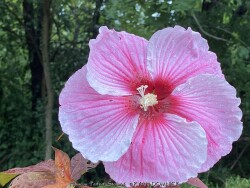

Hardy Hibiscus are US native plants that feature very large single petal flowers sometimes as large as a dinner plate. Colors include white, pink, red, magenta, purple with many different combinations. Foliage can range from green to reddish to dark purplish black. Hardy hibiscus breeding to produce improved cultivars has come a long way in the last 10 or 20 years. Hibiscus emerge later than most other perennials, needing the ground to heat up before growing in May. Hibiscus tolerate a wide range of soil conditions including clay and wetness but prefer rich garden soil. Drought is tolerated with established plants although flowering will be reduced. Generally, the 40 inches of rainfall in Eastern Kansas is sufficient. Full sun is best for optimal foliage coloring, growth habit, and flowers. When used in a landscape, hibiscus brings a tropical feel when flowering and are noticeable from very far away. Combine with hardy bananas (musa basjoo) and other contrasting flowers. Groupings of hibiscus are very effective around water gardens, rain gardens, backyard fences, pollinator gardens, and roadside areas where you only have a second to look when driving by. Modern hibiscus cultivars do not set seed and do not need to be deadheaded like old varieties; the result is continuous blooming from July till September. Cool autumn nights below 50 degrees F initiate beautiful fall foliage colors ranging from red and purple to fiery orange. Maintenance is pretty easy: just cut down dead stocks to the ground at some point in fall or winter. A yearly time-release fertilizer is appreciated from most heavily flowering plants. There are some occasional foliage pests for hibiscuses including leaf miners, grasshoppers, and Japanese beetles but these can be treated. If not treated, it generally won't kill the plant, especially if the plant is otherwise healthy and in good growing conditions. Summerific® 'Perfect Storm' Rose Mallow(Hibiscus 'Perfect Storm') is a Walters Gardens Inc. introduction. A naturally compact selection that works well in large containers. Large 7-8", white flowers with a red eye are produced all over the dense, rounded clump of deep black-purple maple-like leaves. All Proven Winners® plants are legally propagated, healthy and vigorous, true to name, and tagged with color pictures and growing information.
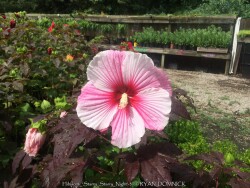

Hardy Hibiscus are US native plants that feature very large single petal flowers sometimes as large as a dinner plate. Colors include white, pink, red, magenta, purple with many different combinations. Foliage can range from green to reddish to dark purplish black. Hardy hibiscus breeding to produce improved cultivars has come a long way in the last 10 or 20 years. Hibiscus emerge later than most other perennials, needing the ground to heat up before growing in May. Hibiscus tolerate a wide range of soil conditions including clay and wetness but prefer rich garden soil. Drought is tolerated with established plants although flowering will be reduced. Generally, the 40 inches of rainfall in Eastern Kansas is sufficient. Full sun is best for optimal foliage coloring, growth habit, and flowers. When used in a landscape, hibiscus brings a tropical feel when flowering and are noticeable from very far away. Combine with hardy bananas (musa basjoo) and other contrasting flowers. Groupings of hibiscus are very effective around water gardens, rain gardens, backyard fences, pollinator gardens, and roadside areas where you only have a second to look when driving by. Modern hibiscus cultivars do not set seed and do not need to be deadheaded like old varieties; the result is continuous blooming from July till September. Cool autumn nights below 50 degrees F initiate beautiful fall foliage colors ranging from red and purple to fiery orange. Maintenance is pretty easy: just cut down dead stocks to the ground at some point in fall or winter. A yearly time-release fertilizer is appreciated from most heavily flowering plants. There are some occasional foliage pests for hibiscuses including leaf miners, grasshoppers, and Japanese beetles but these can be treated. If not treated, it generally won't kill the plant, especially if the plant is otherwise healthy and in good growing conditions. Hibiscus 'Starry Starry Night' is a Walters Gardens Inc. introduction. Incredibly dark, near-black, broad, maple-like leaves form an upright clump in the landscape. Interesting 7-8" flowers are pale pink with darker pink speckling and veining. The flowers are held on bright green carpels, which contrast nicely with the dark foliage. Flowers are produced from the top to the bottom of the plant, rather than only at the top like some older cultivars.
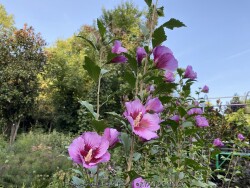

You've never seen a Rose Of Sharon like this before! Purple Pillar® (Hibiscus syriacus 'Purple Pillar') is a totally unique Rose Of Sharon: it naturally grows as a narrow column instead of a wide, spreading plant. It gets to be just 2-3' (.6-.9 m) wide and 10-16' tall! Think of what you could do with that: screens, hedges, patio containers. Anywhere you need a little privacy and/or color in a narrow space, this plant is a great choice. Like most all hibiscus, it will do best in full sun. It is hardy to USDA Zone 5. In summer, each stem is packed along its entire length with purple blooms. This unusual columnar habit makes it a real space saver - if you thought you didn't have enough space to grow Rose Of Sharon, Purple Pillar is perfect for you. Try it in containers, or flanking your front door, or simply as a quirky accent in your landscape. The narrow habit of Purple Pillar Rose Of Sharon means it creates few to no branches, so little to no pruning is required. If you want to prune it, do so in early spring. In areas that experience snowfall, avoid planting it where it might be dumped on by snow falling off of the roof - yours, or your neighbors. In Eastern Kansas, this cultivar performs WELL with just about everything nature has to challenge it! Heat and drought are tolerated full sun or part shade. Our typical 40 inches of rainfall is sufficient without extra water if planted in good soils. Cold tolerance is no problem. No disease or pest problems. Only issue is that seeds will form and re-seeding does not coming true to form: we recommend spraying round-up as seedling appear around the base of the original true Purple Pillar shrubs. You don't want any "non-pillar" wild troublemakers messing up your line. All Proven Winners® plants are legally propagated, healthy and vigorous, true to name, and tagged with color pictures and growing information.
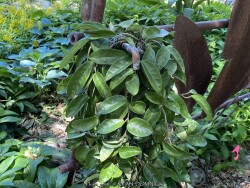

Wax Plants (Hoya sp.) have been popular house plants for decades because they are extremely long-lived, have a classic, deep green, vining foliage and produce fragrant, light pink and red star-shaped flowers. Because of their thick waxy foliage, they are often called wax plants. These tropical vines have a few requirements in order to thrive but nothing too hard. Give them bright indirect light and water only when dry. If light, temperature, and humidity are sufficient, flowers may occur. If not, then just enjoy the beautiful foliage. They are usually grown as a house plant in Kansas but can be moved outside in the summer if kept in full shade. Leaves will sunburn easily! In the wild, most species grow in dry-deciduous jungles that never get below 60 degrees F. Repotting may or may not be needed depending on how large you want the plant to grow; plants can continue to grow in the same pot for decades. If repotting, make sure to use a sharp draining but high organic cactus mix with plenty of sand and perlite. To play is safe, outside potted plants are best moved in before night temperatures get below 50 degrees F. It is important to avoid the combination of wet and cold. Potted plants are very low maintenance but watch for scale and mealybugs that may hide beneath the foliage.
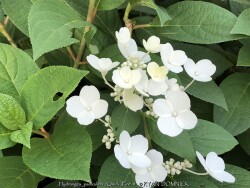

Quick Fire Fab® Panicle Hydrangea (Hydrangea paniculata 'Quick Fire Fab') is the first to bloom! Quick Fire blooms about a month before any other panicle hydrangea. Flowers open pure white then turn pink, and will be an extremely dark rosy-pink in the fall. The flower color on Quick Fire hydrangea is not affected by soil pH. Blooms on this super-hardy and easy to grow hydrangea are produced on new wood, which means that you will see flowers even after even the harshest winters. Beautiful for use as a cut (fresh or dried) flower. Unlike other panicle hydrangeas, Quick Fire Fab also has excellent fall foliage color for a final hurrah before winter. This is a very hardy flowering shrub good for full sun locations - the hotter your climate, however, the more shade the plant will require. Good for groupings and in mass plantings, shrub and perennial borders, as a specimen, a screen or a hedge. Panicle hydrangeas like Quick Fire Fab are very easy to care for. They can grow in most soils, provided they are well-drained. Panicle hydrangeas bloom on new wood, which means they can be pruned in spring and will still bloom that season. We recommend cutting them back by about one-third their total height in early spring, just as the new growth is beginning to emerge on the stems. This will serve to remove the spent blooms and ensure that the season's growth comes from the heavier, thicker buds further down the plant. If blooms do not age to pink and red, this indicates that the plant is either in too much shade, that it experienced drought stress, or that night time temperatures were unusually high. In Eastern Kansas, this cultivar performs reasonably well. Heat and drought are tolerated if in morning sun. In full sun provide ample water and expect some leaf burn if summer temperatures exceed 100 degrees F. Cold tolerance is no problem. No disease or pest problems. All Proven Winners® plants are legally propagated, healthy and vigorous, true to name, and tagged with color pictures and growing information.
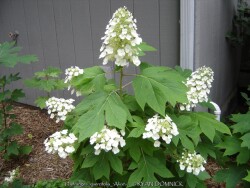

>>>>>Oakleaf hydrangea (Hydrangea quercifolia) is a large coarse-textured deciduous shrub growing to 3-10 feet tall with an open crown native to the southeastern United States. Cone-shaped flower clusters emerge bright white in mid-summer. Flowers age to progressively darker shades of pink and by autumn and become persistent dried flower-heads in winter. The leaves are dark green on top and silvery-white underneath. Plants in shade have larger leaves than those grown in sun. In sun, if drought stress occurs, foliage becomes tattered, burnt, and yellowish; ruining potential fall color. The leaves of healthy plants turn rich shades of red, bronze and purple in autumn that persist until about 25 degrees F usually into late November in Kansas. The plant slowly sprouts shoots from underground stolons and often grows in colonies in ideal conditions but this is rare in Kansas. Young stems are covered in a felt-like light brown bark while the larger stems develop an attractive cinnamon-tan-orange bark that shreds and peels in thin flakes. Hydrangea quercifolia is best grown in rich, medium moisture, well-drained soils in part shade. Drought and full sun tolerance are average but greatly improved with rich, moisture-retentive foresty soils. Plant near gutter downspouts for an extra boost of water. It will tolerate drought, but may not flower. In Eastern Kansas, Cold tolerance is no problem. No significant disease or pest problems. Of all the hydrangeas, this is probably the toughest! Several improved cultivars have been developed.
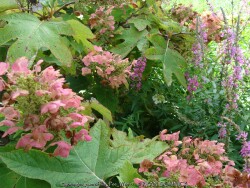

>>>>>Oakleaf hydrangea (Hydrangea quercifolia) is a large coarse-textured deciduous shrub growing to 3-10 feet tall with an open crown native to the southeastern United States. Cone-shaped flower clusters emerge bright white in mid-summer. Flowers age to progressively darker shades of pink and by autumn and become persistent dried flower-heads in winter. The leaves are dark green on top and silvery-white underneath. Plants in shade have larger leaves than those grown in sun. In sun, if drought stress occurs, foliage becomes tattered, burnt, and yellowish; ruining potential fall color. The leaves of healthy plants turn rich shades of red, bronze and purple in autumn that persist until about 25 degrees F usually into late November in Kansas. The plant slowly sprouts shoots from underground stolons and often grows in colonies in ideal conditions but this is rare in Kansas. Young stems are covered in a felt-like light brown bark while the larger stems develop an attractive cinnamon-tan-orange bark that shreds and peels in thin flakes. Hydrangea quercifolia is best grown in rich, medium moisture, well-drained soils in part shade. Drought and full sun tolerance are average but greatly improved with rich, moisture-retentive foresty soils. Plant near gutter downspouts for an extra boost of water. It will tolerate drought, but may not flower. In Eastern Kansas, Cold tolerance is no problem. No significant disease or pest problems. Of all the hydrangeas, this is probably the toughest! Several improved cultivars have been developed.
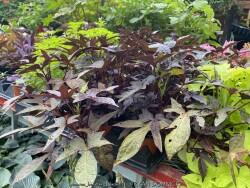

Black Sweet Potato Vine (Ipomoea batatas 'Blackie') is one of the most rapidly growing annuals in out library: it can fill a large annual planting bed after 1 month when planted in May and taking advantage of early summer rains, heat and humidity. It is also great cascading down retaining walls or large pots! Occasional pink flowers do occur but are usually second place behind the attractive foliage. It can handle some drought due to its "sweet potato" underground tuber! It can also be a patio plant, house plant, or hanging basket. If growing as a potted plant and trying to overwinter, allowing the foliage to frost is ok, it will not kill the root system. However, do not allow the pot with rootball to freeze solid or go below 30 degrees for more than a few hours; move into a cold garage or basement over the winter with minimal watering. Allow to go dormant as needed with little care, just cut off dead foliage and place back out in April or May with a time-release fertilizer.
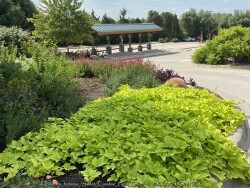

Gold Sweet Potato Vine (Ipomoea batatas 'Sweet Caroline Light Green') is one of the most rapidly growing annuals in out library: it can fill a large annual planting bed after 1 month when planted in May and taking advantage of early summer rains, heat and humidity. It is also great cascading down retaining walls or large pots! Occasional pink flowers do occur but are usually second place behind the attractive foliage. It can handle some drought due to its "sweet potato" underground tuber! It can also be a patio plant, house plant, or hanging basket. If growing as a potted plant and trying to overwinter, allowing the foliage to frost is ok, it will not kill the root system. However, do not allow the pot with rootball to freeze solid or go below 30 degrees for more than a few hours; move into a cold garage or basement over the winter with minimal watering. Allow to go dormant as needed with little care, just cut off dead foliage and place back out in April or May with a time-release fertilizer.
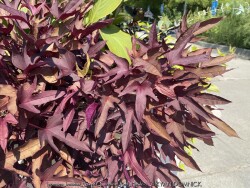

Reddish Purple Sweet Potato Vine (Ipomoea batatas 'Sweet Caroline Red Hawk') is one of the most rapidly growing annuals in out library: it can fill a large annual planting bed after 1 month when planted in May and taking advantage of early summer rains, heat and humidity. It is also great cascading down retaining walls or large pots! Occasional pink flowers do occur but are usually second place behind the attractive foliage. It can handle some drought due to its "sweet potato" underground tuber! It can also be a patio plant, house plant, or hanging basket. If growing as a potted plant and trying to overwinter, allowing the foliage to frost is ok, it will not kill the root system. However, do not allow the pot with rootball to freeze solid or go below 30 degrees for more than a few hours; move into a cold garage or basement over the winter with minimal watering. Allow to go dormant as needed with little care, just cut off dead foliage and place back out in April or May with a time-release fertilizer.
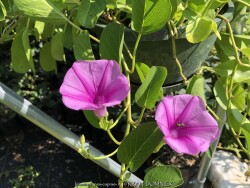

Beach Morning Glory / Railroad Vine (Ipomoea pes-caprae) is the most rapidly growing annual in out library capable of growing 30-50' in one summer! (100-200' in native coastal dune habitats) It can fill a large annual planting bed with bright green foliage after 1 month when planted in May and taking advantage of early summer rains, heat and humidity. It is also great cascading down retaining walls or large pots! Deep root system will grow in pure sand or typical garden soil provided that regular moisture is available. In Eastern Kansas, typically our 40 inches of rainfall is sufficient without extra water in good soils. The magenta flowers are 2-3" across and absolutely beautiful and will get noticed; blooms sporadically in early summer but covered by late summer and early fall in Kansas. Who would have thought that a coastal sand dune stabilization plant would thrive or even grow at all in Kansas? It has been trialed here as a hanging basket plant, cascading wall plant, and mass groundcover in annual beds. If growing as a potted plant and trying to overwinter, it is very difficult as these plants do not like low humidity or low light; best to replace each year.
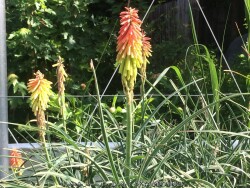

***Description for this perennial available with future update!***
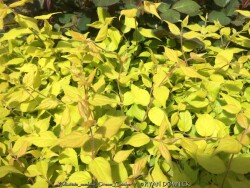

Dream Catcher Beautybush, is also known as Kolkwitzia amabilis 'Dream Catcher'
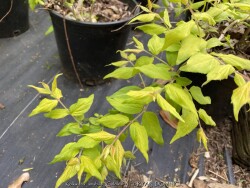

Goldleaf/Golden Beauty Beautybush, is also known as Kolkwitzia amabilis 'Goldleaf'


Dream Catcher Beautybush, is also known as Kolkwitzia amabilis 'Dream Catcher'
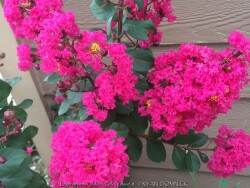

Crapemyrtle (Lagerstroemia) is a beautiful summer flowering shrub that dies down to the ground as a perennial each year in Zone 6 Kansas. Flower colors include bright red, pink, magenta, purple, and white. Many cultivars have been released improving foliage color, disease resistance, and flower blooming length. Newer cultivars now have maroon or reddish foliage adding interest before blooming. Beautiful fall color is often overlooked; shades of red, orange, and purple develop when Night temperatures reach into the 40s. In Kansas, crape myrtles grow best with hot south or west exposures or on south facing berms or hillsides. But they are suitable in any garden location as long as they are in full sun, they will build enough energy to come back from complete winter top-kill each year. Generally are 40 inches of rain per year is sufficient without extra watering, but if drought conditions occur, flowering will be reduced or shortened. Brief periods of excessive water and saturated soils are tolerated adding to their versatility. Many people from the south associate Crapemyrtles as a tree. That is true that in Texas and much of the Southeast, beautiful tree forms with exfoliating bark will occur because of mild winters. In Oklahoma and Arkansas for example crapemyrtles are usually grown as large shrubs experiencing major winterkill every 5-10 years. In Kansas and Missouri, or where temperatures regularly get to 0°, all top growth will die back and they will be grown as a woody perennial. After flowering and beautiful fall color is dropped, many people leave crapemyrtles throughout the winter to enjoy the winter interest of the dried seed heads. By March or April, cut plants close to the ground and watch for new growth. Flowering occurs on new wood and is much larger and more dramatic on sprouts from the ground. Flowers are often twice as big when grown this way. In the past, only fast-growing tree size cultivars for appropriate and Kansas because they have the ability to recover the fastest from complete winterkill and grow into a flowering-sized shrub by July. Now there are dwarf cultivars that are wood-hardy to -10 zone 6 for those not wanting to worry about winterkill. No disease or pest problems. Crapemyrtle are awesome for pollinators in the late season garden and especially effective when combined with vitex, butterfly bush, and/or caryopteris. Lagerstroemia indica 'Pink Velour', developed by Dr. Carl Whitcomb, has deep pink long-lasting flowers. Deep wine red leaves emerge in spring and age to dark purplish green creating quite a contrast with bright flowers.